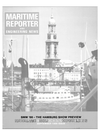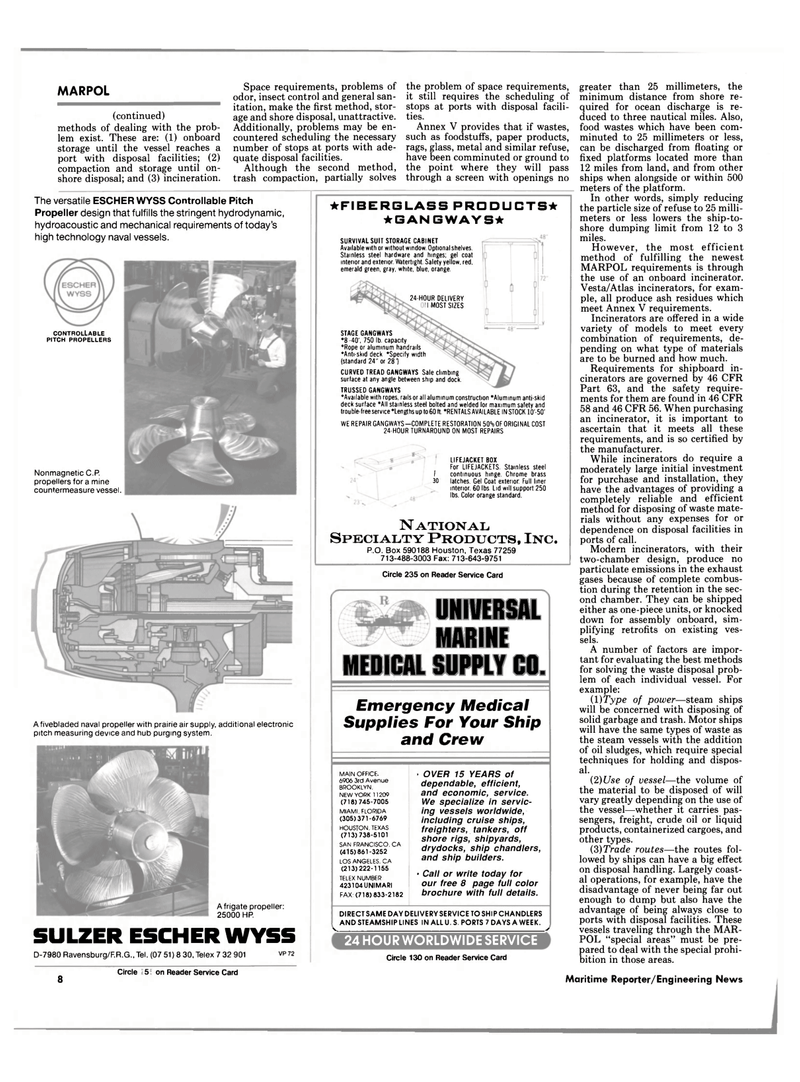
Page 6: of Maritime Reporter Magazine (September 1988)
Read this page in Pdf, Flash or Html5 edition of September 1988 Maritime Reporter Magazine
MARPOL (continued) methods of dealing with the prob- lem exist. These are: (1) onboard storage until the vessel reaches a port with disposal facilities; (2) compaction and storage until on- shore disposal; and (3) incineration.
Space requirements, problems of odor, insect control and general san- itation, make the first method, stor- age and shore disposal, unattractive.
Additionally, problems may be en- countered scheduling the necessary number of stops at ports with ade- quate disposal facilities.
Although the second method, trash compaction, partially solves the problem of space requirements, it still requires the scheduling of stops at ports with disposal facili- ties.
Annex V provides that if wastes, such as foodstuffs, paper products, rags, glass, metal and similar refuse, have been comminuted or ground to the point where they will pass through a screen with openings no 24 HOURWORLDWIDE SERVICE
UNIVERSAL
MARINE
MEDICAL SUPPLY CO.
Emergency Medical
Supplies For Your Ship and Crew
MAIN OFFICE- 6906 3rd Avenue
BROOKLYN,
NEW YORK 11209 (718)745-7005
MIAMI, FLORIDA (305)371-6769
HOUSTON, TEXAS (713)738-5101
SAN FRANCISCO, CA (415)861-3252
LOS ANGELES CA (213)222-1155
TELEX NUMBER 423104UNIMARI
FAX: (718) 833-2182 • OVER 15 YEARS of dependable, efficient, and economic, service.
We specialize in servic- ing vessels worldwide, including cruise ships, freighters, tankers, off shore rigs, shipyards, drydocks, ship chandlers, and ship builders. • Call or write today for our free 8 page full color brochure with full details.
DIRECT SAME DAY DELIVERY SERVICE TO SHIP CHANDLERS
AND STEAMSHIP LINES IN ALL U. S. PORTS 7 DAYS A WEEK.
V J
NATIONAL
SPECIALTY PRODUCTS, INC.
P.O. Box 590188 Houston, Texas 77259 713-488-3003 Fax: 713-643-9751 • FIBERGLASS PRODUCTS* •GANGWAYS*
The versatile ESCHER WYSS Controllable Pitch
Propeller design that fulfills the stringent hydrodynamic, hydroacoustic and mechanical requirements of today's high technology naval vessels.
Circle 235 on Reader Service Card
Circle 130 on Reader Service Card
SURVIVAL SUIT STORAGE CABINET
Available with or without window. Optional shelves.
Stainless steel hardware and hinges; gel coat interior and exterior. Watertight. Salety yellow, red, emerald green, gray, white, blue, orange.
CURVED TREAD GANGWAYS Sale climbing surface at any angle between ship and dock.
TRUSSED GANGWAYS •Available with ropes, rails or all aluminum construction 'Aluminum anti-skid deck surface *AII stainless steel bolted and welded lor maximum safety and trouble-free service'Lengths up to 60 ft. 'RENTALS AVAILABLE IN STOCK 10'-50'
WE REPAIR GANGWAYS-COMPLETE RESTORATION 50% OF ORIGINAL COST 24-HOUR TURNAROUND ON MOST REPAIRS
LIFEJACKET BOX
For LIFEJACKETS. Stainless steel continuous hinge. Chrome brass latches. Gel Coat exterior. Full liner interior. 60 lbs. Lid will support 250 lbs. Color orange standard.
CONTROLLABLE
PITCH PROPELLERS
Nonmagnetic C.P. propellers for a mine countermeasure vessel.
A fivebladed naval propeller with prairie air supply, additional electronic pitch measuring device and hub purging system.
A frigate propeller: 25000 HP.
SULZER ESCHER WYSS
D-7980 Ravensburg/F.R.G., Tel. (07 51) 8 30, Telex 7 32 901 vp72 24-HOUR DELIVERY
I MOST SIZES
STAGE GANGWAYS *8-40'. 750 lb. capacity 'Rope or aluminum handrails •Anti skid deck 'Specify width (standard 24" or 281
I 30 greater than 25 millimeters, the minimum distance from shore re- quired for ocean discharge is re- duced to three nautical miles. Also, food wastes which have been com- minuted to 25 millimeters or less, can be discharged from floating or fixed platforms located more than 12 miles from land, and from other ships when alongside or within 500 meters of the platform.
In other words, simply reducing the particle size of refuse to 25 milli- meters or less lowers the ship-to- shore dumping limit from 12 to 3 miles.
However, the most efficient method of fulfilling the newest
MARPOL requirements is through the use of an onboard incinerator.
Vesta/Atlas incinerators, for exam- ple, all produce ash residues which meet Annex V requirements.
Incinerators are offered in a wide variety of models to meet every combination of requirements, de- pending on what type of materials are to be burned and how much.
Requirements for shipboard in- cinerators are governed by 46 CFR
Part 63, and the safety require- ments for them are found in 46 CFR 58 and 46 CFR 56. When purchasing an incinerator, it is important to ascertain that it meets all these requirements, and is so certified by the manufacturer.
While incinerators do require a moderately large initial investment for purchase and installation, they have the advantages of providing a completely reliable and efficient method for disposing of waste mate- rials without any expenses for or dependence on disposal facilities in ports of call.
Modern incinerators, with their two-chamber design, produce no particulate emissions in the exhaust gases because of complete combus- tion during the retention in the sec- ond chamber. They can be shipped either as one-piece units, or knocked down for assembly onboard, sim- plifying retrofits on existing ves- sels.
A number of factors are impor- tant for evaluating the best methods for solving the waste disposal prob- lem of each individual vessel. For example: (1) Type of power—steam ships will be concerned with disposing of solid garbage and trash. Motor ships will have the same types of waste as the steam vessels with the addition of oil sludges, which require special techniques for holding and dispos- al. (2)Use of vessel—the volume of the material to be disposed of will vary greatly depending on the use of the vessel—whether it carries pas- sengers, freight, crude oil or liquid products, containerized cargoes, and other types. (3)Trade routes—the routes fol- lowed by ships can have a big effect on disposal handling. Largely coast- al operations, for example, have the disadvantage of never being far out enough to dump but also have the advantage of being always close to ports with disposal facilities. These vessels traveling through the MAR-
POL "special areas" must be pre- pared to deal with the special prohi- bition in those areas. 8
Circle 175 on Reader Service Card
Maritime Reporter/Engineering News

 5
5

 7
7
